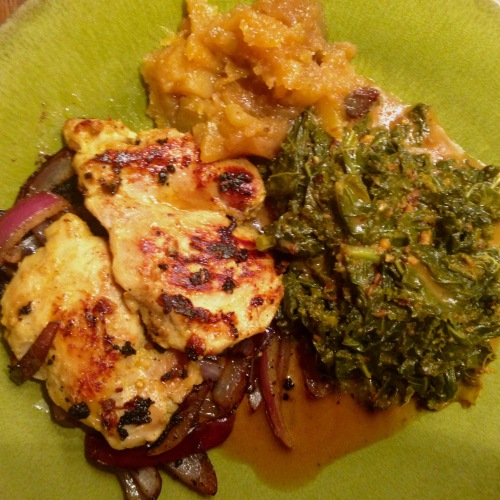A sore throat and persistent headache sent me home early today. I had a hunch I might not be leaving my house for a day or so. On my way home I swung by the grocer to grab ginger, chicken broth, chicken thighs, escarole and milk for tomorrow’s coffee.
For lunch I whipped up a quick soup by simmering the chicken in broth along with some chopped ginger. When the chicken was cooked through, I pulled it out and added soba noodles. Just before serving, I added the meat (now shredded) along with escarole, soy sauce, scallions, cayenne pepper, cilantro and a few drops of sesame oil.
For a brief moment I could breathe clearly and my throat did not ache.
I spent the rest of the afternoon catching up on email and dialing in to various meetings. At some point I managed to knock a nearly full bottle of red wine from the kitchen counter while attempting to make myself a cup of tea.
Naturally, I did not have any paper towels in the house. Cleanup was quite a chore, as was extracting the glass shard that lodged itself under my pinky nail.
By the time I finished, my stomach was growling. I was craving something spicy that would again offer temporary relief from what I am praying is just a cold. I debated making another bowl of soup, but then I flashed on Friday’s late night Indian takeout, which was truly awful. I swear one of the dishes was a can of chickpeas with some curry powder and vegetable oil stirred in and then heated in the microwave.
Surely I could do better with whatever ingredients I had on hand.
Indian Make-In
- 1/2 tablespoon whole coriander seeds
- 1/2 tablespoon whole cumin seeds
- 1 cup plain whole milk yogurt
- 1/4 teaspoon cayenne pepper
- 1/2 teaspoon garam masala
- 1/2 teaspoon turmeric
- 5 garlic cloves
- 1 knob ginger (about the size of your thumb, unless you have monster hands), chopped
- juice of 1 lime (or a Meyer lemon if that’s what you happen to have on hand)
- salt and pepper
- 4 boneless, skinless chicken thighs
- 1 tablespoon ghee (or butter or vegetable oil of some sort)
- 1 bunch kale, large stems stripped, roughly chopped
- 1 pinch sugar
- 1 medium red onion, sliced pole to pole
- cilantro (if you got it)
- Toast the cumin and coriander in a dry cast iron skillet, shaking frequently, until they give off an earthy aroma and darken a bit. Add these along with the yogurt, cayenne, garam masala, turmeric, garlic, ginger, lime juice, a healthy pinch of salt and some black pepper to the small work bowl of your food processor and let run for several minutes. Stir this in with the chicken thighs in a bowl, cover and refrigerate until you decide that you really need to eat. (Overnight would be awesome, but mine sat for about an hour and it was still damn tasty.)
- Bring a cast iron skillet up to medium-high heat with the ghee. Fish the chicken thighs out with a fork, allowing the excess marinade to fall back into the bowl before you place them in the skillet. When the thighs begin to brown, flip them over and baste with the pan juices. Flip back and forth a couple of times continuing to baste. Don’t worry too much about the crust that’s forming (provided your pan is well seasoned).
- Meanwhile, scrape the leftover marinade into a small saucepan and bring up to medium-high heat. Add the kale in batches, along with a cup or so of water and a pinch of sugar. Let this continue to boil, adding water if needed. (You’re aiming for something approximating spicy creamed spinach.) You may opt to add additional salt, pepper or cayenne as indicated.
- When the chicken thighs are done, set them aside and give the pan a good scrape, transferring the crusty bits to your simmering kale. Add the red onion to your skillet and cook, stirring frequently, until limp and nicely charred in spots. Cilantro would be awesome to finish the dish. Alas, I tossed it all into my chicken soup.
If I were serving this for company, I would have made a pot of Basmati rice. Instead, I packed half away for tomorrow and added a dollop of mango chutney.
You know what would have been good with this meal? A nice glass of red wine. Sigh.

































